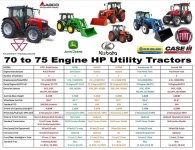New tractors are generally in short supply and thus used ones have become pricey as well.
Deere's pre-emissions tractors in the 60-70 HP range would be certain 5000 series machines up until 2013, and before that, the smaller members of the 2x40/2x50/2x55 series as they introduced MFWD on the 40 series units in this HP range. I will say that MFWD was pretty uncommon until roughly the late 1990s, so it would be pretty uncommon to find a 40/50/55 series unit with it and it wasn't even that common on the first 5x00 units. The units you would want to look for are the 5300 and 5400, 5310, 5320, 5303, 5325, 5403, and 2008-2013 5065E and 5075E as well as 5065M and 5075M. Do note that the 5065E, 5075E, and 5075M are still made and you would need to narrow your search to 2013 and older units in order to not turn up 2014-up Tier 4 units if you want a pre-emissions tractor. These tractors depending on year and model series could have an unsynchronized 3-range/3-speed Collar Shift transmission, a 3-range/3-speed synchronized SyncShuttle (also called the TSS or "top shaft synchronized") transmission which does NOT have a shuttle lever, or one of a few different hydraulic reverser (PowrReverser) transmissions with the shuttle lever, most commonly a three-range/four-speed unit. Deere never made a mechanical shuttle transmission for these tractors with a shuttle lever like you would see on a New Holland Workmaster 60 or 70 aka the CaseIH Farmall 60A and 70A. They also never made a hydrostatic transmission for this size of tractor either.
The Deere 5000 series are a nice tractor, the same basic design has been made since the early 1990s and the basic 3 cylinder 179 CID/2.9 L engine in nearly all of those has been made since the 1970s. The exception here is the 5325 and Tier 2 5065M/5075M. They used a five-cylinder skid loader engine and the 5M used/uses a new, different, larger frame than the other tractors in this list. I have run several three and four-cylinder versions in the 5000 line over a couple of decades, both cabbed and open station, 2WD and MFWD, and with the TSS as well as 12-speed PowrReverser transmissions. They all worked well, I personally prefer the TSS transmission despite there being no reverser lever, but that is personal preference.
Deere's comparable models to the
M6040 and
M7040 would have been the 2008-2013 5055E and 5065E/5065M.
Regarding loader carriers, the "ALO" type above is called Global and is an ISO spec. CaseIH/New Holland as well as John Deere give it as an option on some loaders. The other carrier CaseIH/New Holland uses is the skid loader QA, which is an option if not the only setup offered on loaders on <75 HP tractors. Deere offers their own hook-and-linch pin JD 500 QA on all of their 500 series loaders, and on some loaders they offer Global and on some new ones, skid loader QA. Kubota appears to only use the skid loader QA on tractors of this size. I personally like the JD QA as it's the easiest and most foolproof of the three mentioned above, and it is not proprietary. Most 500 series Deere loaders made before about 2010 or so are going to be Deere QA.
I will also say to not rule out a 2WD utility tractor unless you have actually used a 2WD utility tractor on your property and had issues with it. A utility tractor has a lot more weight than a compact, and particularly with the fluid-filled ag (R1) tires that generally come on them, a 2WD utility tractor will get a lot more traction than compact tractor with MFWD disengaged will get. They work just fine with a loader, you just need to have appropriate ballast, which you are supposed to have on
any tractor with a loader. With the exception of the smaller Kubota M series units with their bevel gear MFWD as you see in a compact tractor, the 2WD tractors have a much smaller turning radius than a regular planetary-hub MFWD utility tractor as well, which is why they are popular for haying operations around here.

